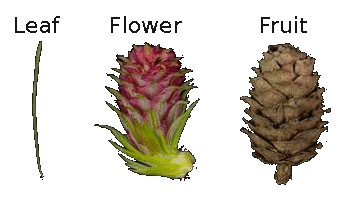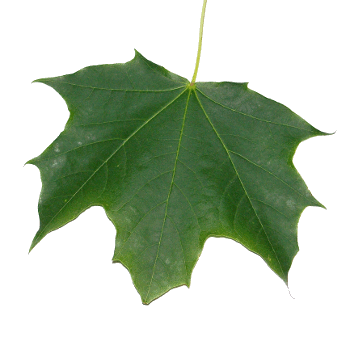The Larch
June 15, 2011
Some of you might remember the
Larch sketch from
Monty Python's Flying Circus, who thought that "
How to Recognise Different Types of Trees From Quite a Long Way Away" was a good theme for a television show. The
Larch is actually quite interesting scientifically, since it's the only
deciduous pine; that is, it loses its
leaves in the
autumn.

European Larch (Larix decidua), found also in eastern North America.
Via Leafsnap Web Site
(See Ref. [1])
I enjoyed my
secondary school biology course. It was
BSCS Biology, a type of "new" biology that followed the trend started with
"new" math. We did experiments with
frog pituitary glands, and we were able to work in a laboratory of a local college to make
microtome sections of the glands. But I was a
dyed-in-the-wool physicist, so I never took a biology course after that.
I was forced back into the world of biology by my children when they studied biology in
elementary school. A common and easy biology project for elementary school students is collecting and classifying tree leaves. The process seemed to affirm
Rutherford's comment that "All science is either physics or stamp collecting." In
Linnaeus' defense, you need to start somewhere.
Those leaf collecting projects could have been aided by a computer application recently developed by scientists from
Columbia University, the
University of Maryland and the
Smithsonian Institution. The scientists on this team are heavily weighted towards
computer science, since the application is an extension of
facial recognition technology to the identification of tree leaves.[1-7]
Leafsnap is a free mobile computer application that's presently available for the
iPhone and
iPad, and it's being ported to other systems, including
Android. The application is designed to identify a tree species from a photograph of a leaf. Possibly because of the locations of the developers, the current tree database is for trees that are found in the
New York City and
Washington, D.C. areas. The Leafsnap application was tested at New York's
Central Park, and at
Plummers Island,
Maryland,[3] It's planned to extend the dataset to include the entire
contiguous United States.
I wrote about
crowdsourcing in
yesterday's article (All the Marbles, June 14, 2011). Leafsnap is a crowdsource application, since users can upload geotagged images of trees they have identified. This allows monitoring of a tree population's health over time.[6] Those who don't have one of the supported mobile computers can still make use of the web site that hosts leaf and other images of various tree species (see the above photograph).
The computer technology for this application came from the research groups of
Peter Belhumeur of Columbia University and and
David Jacob of the the University of Maryland. The size of the Leafsnap team is huge, as can be seen from the Leafsnap web site.[2]
Finding Species, a non-profit nature photography group, did the exquisite photography.[6]
Understandably, the Leafsnap application doesn't give you an answer with 100% certainty. Instead, it gives you five or ten choices, with your tree's particular species typically the first or second choice.[3] Other descriptive data, such as the typical locations, the time of year for flower bloom, and images of the fruits, seeds and bark, allow you to make a final decision.[6]
The matching
algorithm was trained using about twenty leaves for each species. The 157 species on Plummers Island were represented by 5,013 leaves, and the 144 species in Central Park were represented by 4,320 leaves.[3] The image matching algorithms, which look at reference points on a leaf's outline,[6] were designed by
David W. Jacobs, associate professor at the University of Maryland.[3]
One Internet commentator had an observation about this computer application that relates to my children's experience on their leaf collection-identification assignment. If children can identify a leaf in a matter of seconds, with no effort, are they really learning?[4] They might not be inspired to become
botanists, but they may be inspired to become
computer scientists.
How would you do a leaf identification algorithm? Mine wouldn't use facial recognition at all. It would involve finding the
centroid of the leaf, identifying the
stem position, and then mapping the leaf as an angle-radius
function about the center. Identifying the
extrema of the function would give you the number of lobes on the leaf, which would reduce the number of candidates considerably. Fitting the function would take you to the next level.
There's a YouTube demonstration of Leafsnap.[7] The
National Science Foundation funded this work.

I don't have an iPhone or iPad, but I do have several maple trees around my house.
The Leafsnap web site identifies this as the leaf of a Norway Maple (Acer platanoides).
(Photo by author)
![]()
References:
- European Larch (Larix decidua) on the Leafsnap Web Site.
- Leafsnap: An Electronic Field Guide, Leafsnap Web Site.
- Anne Eisenberg, "Digital Field Guides Eliminate the Guesswork," The New York Times, May 9, 2009.
- Leo Hickman, "The mobile phone app that can identify a tree by its leaf," Guardian (UK), May 6, 2011.
- What's That Tree? New Leaf-ID App Can Tell You, OurAmazingPlanet, May 3, 2011.
- Mark Brown, "Free iPhone App Identifies Tree Leaves," Wired, May 9, 2011.
- Introducing Leafsnap, YouTube video, Smithsonian Institution (Brian Ireley with Sarah Taylor, Producers).
Permanent Link to this article
Linked Keywords: Larch sketch; Monty Python's Flying Circus; How to Recognise Different Types of Trees From Quite a Long Way Away; Larch; deciduous; pine; leaves; autumn; Leafsnap; secondary school; biology; BSCS Biology; "new" math; frog; pituitary gland; microtome; dyed-in-the-wool; physicist; elementary school; Ernest Rutherford; Linnaeus; Columbia University; University of Maryland; Smithsonian Institution; computer science; facial recognition technology; iPhone; iPad; Android; New York City; Washington, D.C.; Central Park; Plummers Island; Maryland; contiguous United States; crowdsourcing; Peter Belhumeur; David Jacob; Finding Species; algorithm; David W. Jacobs; botanist; computer scientist; centroid; stem<; function; extrema; National Science Foundation.